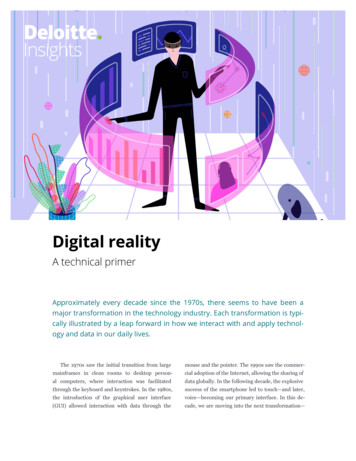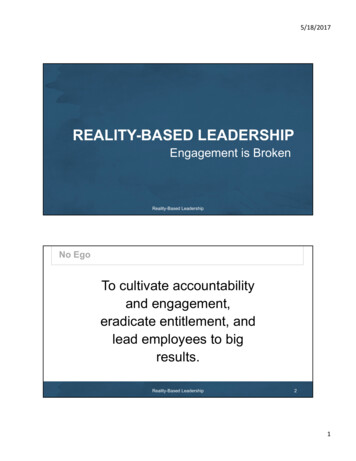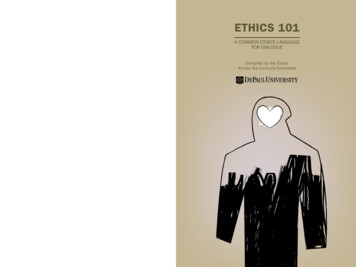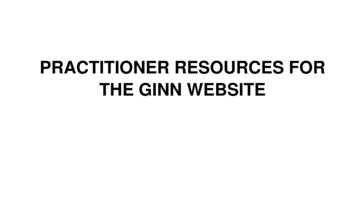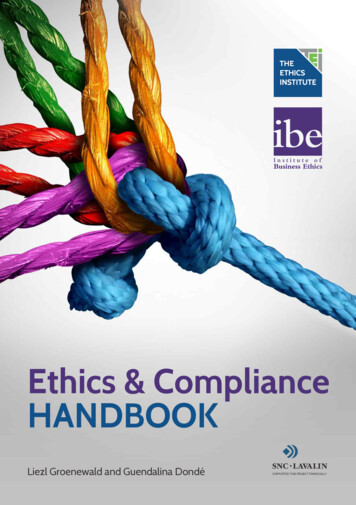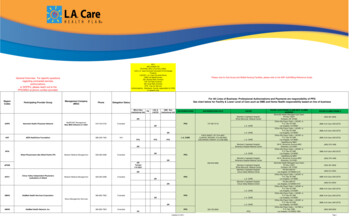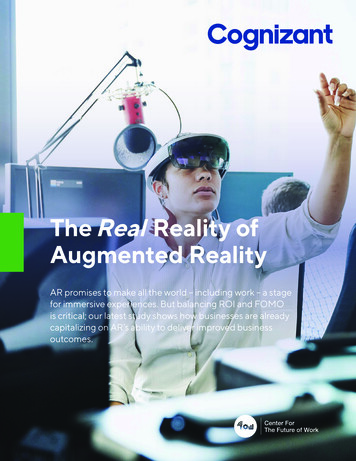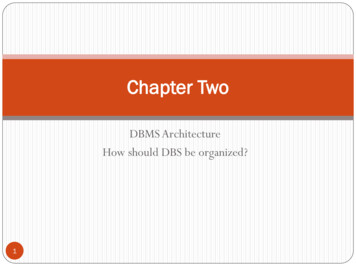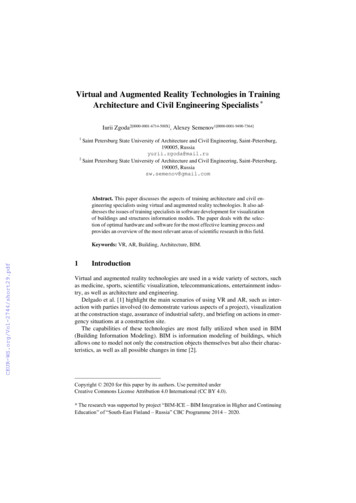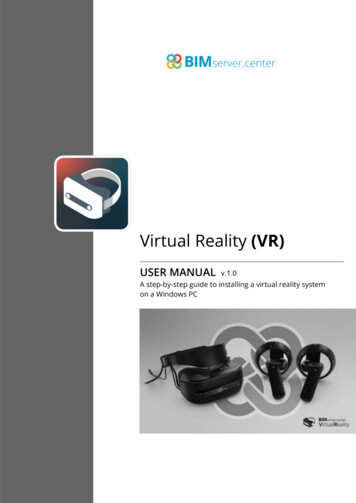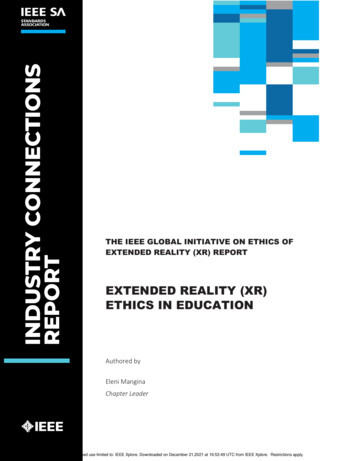
Transcription
INDUSTRY CONNECTIONSREPORTTHE IEEE GLOBAL INITIATIVE ON ETHICS OFEXTENDED REALITY (XR) REPORTEXTENDED REALITY (XR)ETHICS IN EDUCATIONAuthored byEleni ManginaChapter LeaderAuthorized licensed use limited to: IEEE Xplore. Downloaded on December 21,2021 at 16:53:49 UTC from IEEE Xplore. Restrictions apply.
TRADEMARKS AND DISCLAIMERSIEEE believes the information in this publication is accurate as of its publication date; such information is subject to changewithout notice. IEEE is not responsible for any inadvertent errors.The ideas and proposals in this specification are the respective author’s views and do not represent the views of the affiliatedorganization.ACKNOWLEDGEMENTSSpecial thanks are given to the following contributors of this paper:Athanasios ChristopoulosDidier ContisGeorgia LivieriFarzin MatinMathanaMeredith NoelleNathalie MatheRebekah DavisSamira KhodaeiStylianos MystakidisThommy ErikssonTobias LoetscherThe Institute of Electrical and Electronics Engineers, Inc. 3 Park Avenue, New York, NY 10016-5997, USACopyright 2021 by The Institute of Electrical and Electronics Engineers, Inc.All rights reserved. 15 December 2021. Printed in the United States of America.PDF:STDVA25107 978-1-5044-8201-1IEEE is a registered trademark in the U. S. Patent & Trademark Office, owned by The Institute of Electrical and Electronics Engineers,Incorporated. All other trademarks are the property of the respective trademark owners.IEEE prohibits discrimination, harassment, and bullying. For more information, es/p9-26.html.No part of this publication may be reproduced in any form, in an electronic retrieval system, or otherwise, without the prior writtenpermission of the publisher.Find IEEE standards and standards-related product listings at: http://standards.ieee.org.2IEEE SACopyright 2021 IEEE. All rights reserved.Authorized licensed use limited to: IEEE Xplore. Downloaded on December 21,2021 at 16:53:49 UTC from IEEE Xplore. Restrictions apply.
NOTICE AND DISCLAIMER OF LIABILITY CONCERNING THE USEOF IEEE SA INDUSTRY CONNECTIONS DOCUMENTSThis IEEE Standards Association (“IEEE SA”) Industry Connections publication (“Work”) is not a consensus standard document.Specifically, this document is NOT AN IEEE STANDARD. Information contained in this Work has been created by, or obtainedfrom, sources believed to be reliable, and reviewed by members of the IEEE SA Industry Connections activity that producedthis Work. IEEE and the IEEE SA Industry Connections activity members expressly disclaim all warranties (express, implied,and statutory) related to this Work, including, but not limited to, the warranties of: merchantability; fitness for a particularpurpose; non-infringement; quality, accuracy, effectiveness, currency, or completeness of the Work or content within theWork. In addition, IEEE and the IEEE SA Industry Connections activity members disclaim any and all conditions relating to:results; and workmanlike effort. This IEEE SA Industry Connections document is supplied “AS IS” and “WITH ALL FAULTS.”Although the IEEE SA Industry Connections activity members who have created this Work believe that the information andguidance given in this Work serve as an enhancement to users, all persons must rely upon their own skill and judgment whenmaking use of it. IN NO EVENT SHALL IEEE OR IEEE SA INDUSTRY CONNECTIONS ACTIVITY MEMBERS BE LIABLE FOR ANYERRORS OR OMISSIONS OR DIRECT, INDIRECT, INCIDENTAL, SPECIAL, EXEMPLARY, OR CONSEQUENTIAL DAMAGES(INCLUDING, BUT NOT LIMITED TO: PROCUREMENT OF SUBSTITUTE GOODS OR SERVICES; LOSS OF USE, DATA, OR PROFITS;OR BUSINESS INTERRUPTION) HOWEVER CAUSED AND ON ANY THEORY OF LIABILITY, WHETHER IN CONTRACT, STRICTLIABILITY, OR TORT (INCLUDING NEGLIGENCE OR OTHERWISE) ARISING IN ANY WAY OUT OF THE USE OF THIS WORK, EVENIF ADVISED OF THE POSSIBILITY OF SUCH DAMAGE AND REGARDLESS OF WHETHER SUCH DAMAGE WAS FORESEEABLE.Further, information contained in this Work may be protected by intellectual property rights held by third parties ororganizations, and the use of this information may require the user to negotiate with any such rights holders in order tolegally acquire the rights to do so, and such rights holders may refuse to grant such rights. Attention is also called to thepossibility that implementation of any or all of this Work may require use of subject matter covered by patent rights. Bypublication of this Work, no position is taken by the IEEE with respect to the existence or validity of any patent rights inconnection therewith. The IEEE is not responsible for identifying patent rights for which a license may be required, or forconducting inquiries into the legal validity or scope of patents claims. Users are expressly advised that determination of thevalidity of any patent rights, and the risk of infringement of such rights, is entirely their own responsibility. No commitmentto grant licenses under patent rights on a reasonable or non-discriminatory basis has been sought or received from any ieee.org/about/bog/iccom/.This Work is published with the understanding that IEEE and the IEEE SA Industry Connections activity members are supplyinginformation through this Work, not attempting to render engineering or other professional services. If such services arerequired, the assistance of an appropriate professional should be sought. IEEE is not responsible for the statements andopinions advanced in this Work.3IEEE SACopyright 2021 IEEE. All rights reserved.Authorized licensed use limited to: IEEE Xplore. Downloaded on December 21,2021 at 16:53:49 UTC from IEEE Xplore. Restrictions apply.
TABLE OF CONTENTSABSTRACT . 51.INTRODUCTION . 62. LEGACY ACCESS AND PLANNED OBSOLENCE. 63. RECOMMENDATIONS . 74. CHALLENGES . 85. STAKEHOLDERS AND LEADERSHIP . 86. XR ETHICS IN EDUCATION REQUIREMENTS . 106.1. PRIVACY . 106.2. REGIONAL ETHICS LAWS IN EDUCATION . 116.2.1. UNITED STATES . 116.2.2. EUROPE . 116.2.3. EAST ASIA . 126.3. PRIVACY IN EDUCATION REQUIREMENTS . 146.4. USER REQUIREMENTS . 156.5. HARDWARE REQUIREMENTS . 156.6. SOFTWARE REQUIREMENTS . 167. XR ETHICS IN EDUCATION 3D EDUCATIONAL CONTENT . 167.1. ACCESSIBILITY . 177.2. TEACHING AND LEARNING. 177.3. AUTHORING TOOLKITS . 188. XR ETHICS IN EDUCATION IMPACT . 188.1. EDUCATIONAL . 198.2. SOCIETAL . 199. CONCLUSIONS . 209.1. GENERAL . 219.2. CHALLENGES . 2110. REFERENCES . 22Authorized licensed use limited to: IEEE Xplore. Downloaded on December 21,2021 at 16:53:49 UTC from IEEE Xplore. Restrictions apply.
THE IEEE GLOBAL INITIATIVE ON ETHICS OFEXTENDED REALITY (XR) REPORTEXTENDED REALITY (XR)ETHICS IN EDUCATIONABSTRACTThis report is the result of work within the IEEE Global Initiative on Ethics of Extended Reality (XR), amultidiscipline group of industry practitioners, ethicists, academics, researchers, educators, andtechnology enthusiasts. It has been written to focus on a wide range of ethical issues related to XR andthe ownership of second lives. This report builds on work outlined in the “Extended Reality” chapter of theIEEE’s seminal ethics-focused publication Ethically Aligned Design. XR is a term used to broadly refer to asuite of immersive technologies including virtual reality, augmented reality, and spatial computing. Thescope of this report is the exploration of ethics-related issues to support the development, design, anddeployment of XR applications in education and the aim is to initiate expert-driven, multidiscipline analysisof the evolving XR Ethics requirements, with a vision to propose solutions, technologies, and standards infuture updates. The set of recommendations within this report will hopefully contribute to industryconceptualization of socio-technological issues, highlight concreted recommendations, and lay thegroundwork for future technical-standardization activities.MONIQUE J. MORROW & MATHANACHAIR & VICE CHAIRIEEE GLOBAL INITIATIVE FOR ETHICAL EXTENDED REALTY5IEEE SACopyright 2021 IEEE. All rights reserved.Authorized licensed use limited to: IEEE Xplore. Downloaded on December 21,2021 at 16:53:49 UTC from IEEE Xplore. Restrictions apply.
1. INTRODUCTIONImmersive technologies (XR) in education offer a number of opportunities (e.g., facilitating Authentic LearningExperiences; empowering learners as creative designers and makers; integrating immersive storytelling inlearning; integrating immersive learning in STEM; fostering collaboration with Social VR and other XR technologies;cultivating immersive and blended-reality learning spaces and laboratories; developing the capabilities of thefuture workforce) [1], but the convergence with artificial intelligence (AI) can have a profound impact on ethicsconsiderations for applications at all levels [2]. Utilizing AI in XR can reshape human experience and socialinteractions in education, but one of the barriers for adoption is the lack of policy on XR ethics for education [3],[4]. Ethics XR for education is a broad topic that needs to be present within the different levels of education. Someof the sections within this paper are intertwined with the rest of the separate papers that make up the report asa whole (i.e., privacy, social harassment, accessibility). This paper describes the most important issues for XR ethicsin education at all levels and proposes an initial set of recommendations in this space with a view to furtherdevelop a more detailed policy on ethics XR for education for reference from all levels [5].2. LEGACY ACCESS AND PLANNEDOBSOLENCEGenerally, schools move very slowly in adopting new Information Communication Technologies (ICT) tools due tothe lack of evidence-based results of XR systems’ impact in education and the large-scale investment needed fromgovernments. However, the most important factor is severely limited resources, such as time. For many teachers,finding a new ICT tool or a new set of learning material is a major investment in time, considering how little timeis available for teaching-related tasks involving researching, learning, and planning for new tools [6]. Therefore,when practitioners eventually find ICT tools that work well for their classrooms, they might keep using thattechnology for years or even decades beyond which these tools can be supported. This slow ICT adoption andtendency to use specific tools and content for a very long time are in conflict with a typical schedule of plannedobsolescence [7] of both hardware and software, as well as the speed at which content platforms become legacysystems [8].There is a wider issue than just the individual teachers struggling to keep old systems working and finding newtools and content. Funds for new technology are often lacking in schools, which slows the spread of new ICT ineducational institutions. From a societal perspective, it is a waste of resources to develop specific learning materialthat could have been giving returns on investment for many years or even decades, but is instead used only two6IEEE SACopyright 2021 IEEE. All rights reserved.Authorized licensed use limited to: IEEE Xplore. Downloaded on December 21,2021 at 16:53:49 UTC from IEEE Xplore. Restrictions apply.
to three years before it becomes unusable. There is also a historical perspective in which developing content anddesigning experiences are to a very high degree based on designers’ experience of previous products. This is anatural part of inspiration for a design process [9]. In the production of, for example, music, movies, and literature,a movie maker might become inspired by watching old movies, and there may be many other sources ofinspiration. Within XR development, designers have access to a comparatively limited canon of XR products,especially those intended for educational use.Another important issue is the existing policies on privacy laws that impact education, which have not kept upwith the pace of technology [10], [11]. Any instructional activities in which students create data, or during whichdata is recorded about students, will fall under Family Educational Rights and Privacy Act (FERPA) or General DataProtection Regulation (GDPR). An aspect of relevance here is the problem of persistence of the data created withintegrity and ownership of said content, especially that which is created through scanning of the physical worldand that which is created in any collaborative XR platforms [12]. XRSI has released a novel privacy frameworkversion 1.0 (Title VI and Title IX with potential impact on universities trying to adopt XR), which sets a baseline setof standards, guidelines, and best regulation-agnostic practices [13].3. RECOMMENDATIONSPolicies and recommendations on Digital Learning 2020 exist that are related to reporting on practice in earlylearning and care; primary and post-primary contexts, with minimum reference to the prospect of XR educationalsystems. The focus within practices of digital learning for adoption of ethically XR should focus on the following: XR Digital Strategy for Schools XR Digital Teaching and Learning Framework Ethically approved XR Teaching and Learning methodology XR technologies to ethically encourage active and collaborative learning XR technologies to ethically create new knowledge, content, and 3D artifacts XR technologies supporting effective teaching and learning assessment strategiesWithin XR for education, consideration must be made for the effect XR technologies would have on students andtheir learning process outcomes. Which XR factors should be under the control of policy makers to produce thebest performance outcomes, while at the same time ensuring ethical integrity and respect users’ control?Although within the current educational system spectrum there are predefined factors for the progression of anindividual student, specific factors must be considered depending on the level of education at which the XRtechnology is to be adopted:7IEEE SACopyright 2021 IEEE. All rights reserved.Authorized licensed use limited to: IEEE Xplore. Downloaded on December 21,2021 at 16:53:49 UTC from IEEE Xplore. Restrictions apply.
Impact of educational policies and resources for the adoption of XR in education Definition of educational equality and equity within XR in education Level of impact of XR toward the contribution to quality and equity in student performance The structure of differentiation within education systems and the applicability of XR within thosesystems Decentralization of ethically approved XR educational systems4. CHALLENGESPotential challenges are as follows: Equity: Will XR Educational systems increase the educational divide? Acceptance: What level of readiness do stakeholders have for XR technology adoption? Safety: What is safe use of software in terms of both physical health and mental health anddata analytics within XR education? And what unintended consequences may arise? Privacy: How do students retain control over their biometric and psychometric data withineducational context when using XR technology? How can students be ensured that their use ofXR technology will be prejudiced opportunities for advancement?5. STAKEHOLDERS AND LEADERSHIPAn important aspect impacting the ethical use of technology in teaching and learning is the different groups ofstakeholders involved (e.g., students, teachers, administrators, parents) and the hierarchical leadership structurein schools and school systems. This varies quite a bit among educational levels and individual countries andregions, but generally a hierarchical power structure can be assumed. The autonomy of different stakeholders,especially with the grass-root teacher, varies almost infinitely when it comes to choosing and using ICT in theclassroom. An example of a teacher with very low autonomy is a lower grade teacher with low interest in usingtechnology, as well as with a low level of ICT literacy [14]. On the other hand, a teacher with a typically high levelof autonomy would be a university teacher with high interest in technology. The former often use whatever ishanded to them, while the latter may often decide on their own equipment and tools with no regard to topmanagement decisions whatsoever [15]. The following stakeholders are listed: National (or state) central administrative authority for the public school system: Typically controlsregulations, resource distribution, and sometimes central implementation of IT infrastructure.8IEEE SACopyright 2021 IEEE. All rights reserved.Authorized licensed use limited to: IEEE Xplore. Downloaded on December 21,2021 at 16:53:49 UTC from IEEE Xplore. Restrictions apply.
School top management (e.g., headmaster or principal): Typically controls staffing, resourcedistribution, and strategy. Their interest and engagement in ICT for learning may vary widely fromschool to school. A significant risk at this level is that this group can be misled by quick fixes andmagic bullets promised from technology and content providers. Providers of hardware, software, platforms, and content: The large scale of the school systemprovides these companies with a potentially very lucrative market and not all providers can beregarded as serious. For this group, skill and insight in pedagogy may be especially low. Textbookcompanies, proctoring software developers, and consumer electronic manufactures may find theirtools and services being procured for the classroom without due diligence for unintended negativeexternalities. School-based IT department: Typically controls set-up of all computers at the school. Usually isresponsible for regulating the settings of firewalls, what software can be installed, etc. and may bequite rigid with this. These stakeholders tend to prioritize a safe computer infrastructure beforeexperimentation with new ICT tools. ICT pedagogy experts: Whether from technology associations, local institutions of higher education,or within the school system, these individuals can have a major influence on how ICT is used at aschool, if this role exists at all, especially if they have proper mandate from top management. Learning material curators/Purchasers: The actual role of these individuals varies. This role may ormay not exist at each specific school. Teachers/Instructors: Within the complex and sometimes limiting constraints, created by thestakeholders above in the hierarchy, the teachers have much control over what and how technologyis used in the classroom, especially how often and for what purpose. Learners: Learners typically use what the school provides, especially in the lower grades. In HigherEducation the students can, in some situations, be highly autonomous when it comes to selection ofICT tools and learning material. At this level they often bring their own devices to the educationalsetting. Parents and guardians: Typically have very low insight or control over devices or programs, but insome parent-owned or private schools this might be different.9IEEE SACopyright 2021 IEEE. All rights reserved.Authorized licensed use limited to: IEEE Xplore. Downloaded on December 21,2021 at 16:53:49 UTC from IEEE Xplore. Restrictions apply.
6. XR ETHICS INEDUCATION REQUIREMENTSEducators must remain mindful that Immersive Virtual Reality (IVR) and generally XR can amplify and multiplychallenges of traditional media (though there remains a pacing gap with XR used for teaching and learningbetween innovation, regulation, and policy [16], [17], [18]. Privacy issues concerning users’ data, XR’s potentialimpact on physical and psychological well-being, along with possibilities for surveillance abuse are some essentialconcerns [19], [20].6.1.PRIVACYPrivacy, from the perspective of XR ethics in education, can help developers, teachers and enterprises establishand improve their code of conduct when it comes to privacy from an ethical point of view. Establishing a code ofconduct makes all individuals utilizing XR technologies within educational frameworks accountable for protectingvaluable data. Although the Children’s Online Protection Privacy Act (COPPA) [21] imposes certain requirementson operators of websites or online services directed to children under 13 years of age and on operators of otherwebsites or online services that have actual knowledge that they are collecting personal information online froma child under 13 years of age, there is still no specific guide and policy on requirements for ethics of XR applicationsused in education. The types and amount of personal information that could potentially be gathered by an XRdevice or application demands particular attention when it comes to children, and even students in highereducation who are adults, yet under the direction of instructors with power to determine their success or failurein education [22], [23].In addition to privacy issues, XR applications in education need to establish a sustainable methodology forinteractive technologies utilization within different levels of education as technology directly mediates personalperception of and interaction with the physical world. From the perspective of how XR might be used foreducational purposes, this presents exciting opportunities, but also creates security and safety concerns muchmore pressing, and potentially dangerous, compared with any issues raised by other existing technologies that donot directly affect our view of reality.Furthermore, XR as a surveillance mechanism within education could have an impact on students: “’HighSurveillance’ Schools Lead to More Suspensions, Lower Achievement” (EdWeek) [24], which the surveillanceenabled pedagogy could inflict harm to students (Reject Test Surveillance in Schools) [25]. Remote proctoring isalready incredibly invasive [26], and the use of XR in proctoring could bring about even more granular (e.g.,volumetric, biometric) surveillance in homes and classrooms [27], [28].10IEEE SACopyright 2021 IEEE. All rights reserved.Authorized licensed use limited to: IEEE Xplore. Downloaded on December 21,2021 at 16:53:49 UTC from IEEE Xplore. Restrictions apply.
6.2.REGIONAL ETHICS LAWS IN EDUCATIONIt is important for XR education products to respect citizen rights (as required by the Lisbon Treaty EuropeanCharter of Fundamental Rights which came into force 1 December 2009), as well as societal relevance. Ethicsrequirements enable better design and a methodology for standardized ethics requirements for XR Education willtransform the ways in which people learn and teach within XR environments.6.2.1. UNITED STATESIn the United States, individual states set forth codes of ethics for educators employed by the government(examples 505-6-.01 and QP-C-014). A wide variety of education organizations such as the NEA (like many othercontent/level associations) have also published ethics guides for their members. These policies and documentsare rarely specific enough to provide recommendations or guidelines for technology use, much less for the mostcurrent iterations of XR technologies. However, particular ethical considerations that might be applied directly tothe topic of XR in education include those regarding the health and safety of students in an educators’ charge,maintaining appropriate relationships with students, and maintaining in confidence information related to thestudents’ work [29]. That last point aligns with the previously mentioned law(s) typically applied to ICT ineducation in the United States, FERPA. FERPA is the Family Educational Rights and Privacy Act (FERPA) (20 U.S.C.§ 1232g; 34 CFR Part 99). It is a federal law that protects the privacy of student education records for schoolsfunded from the U.S. Department of Education. FERPA gives parents certain rights with respect to their children’seducation records. These rights transfer to the student when he or she reaches the age of 18 or attends a schoolbeyond the high school level. Students to whom the rights have transferred are “eligible students.”6.2.2. EUROPEEUROPE The EU General Data Protection Regulation (GDPR), in force since 25 May 2018, replaced the existingdata protection framework under the EU Data Protection Directive [11]. The EU GDPR is intended to protect thefundamental rights and freedoms of individuals in the context of technological development and also to helpachieve policy objectives linked to the digital single market. In order to protect personal data, XR educationalproducts should consider the following two new procedures introduced by the GDPR: Data Protection Impact Assessments (DPIAs): Operators and authorities that collect and use(“process”) personal data are required to implement such assessment procedures any time theirprocessing operations is evaluated to be a high risk to the rights and freedoms of humans. This isa requirement under Article 35 of the Regulation.11IEEE SACopyright 2021 IEEE. All rights reserved.Authorized licensed use limited to: IEEE Xplore. Downloaded on December 21,2021 at 16:53:49 UTC from IEEE Xplore. Restrictions apply.
Data Protection by Design and by Default (DPbD): Requires identification of ways of engineeringand integrating safeguards for personal data into technology and its settings. This procedure isintroduced by Article 25 of the Regulation.The EU GDPR and its articles refer to the processing of Personal Data, which for the purposes of the regulationrefers to any data relating to an identified or identifiable ‘data subject.’ Thus, the EU definition of personal data isvery broad; whereas, in the United States the processing of personal information is generally permitted andsubject to a patchwork quilt of laws in the U.S. that define specific data elements as personal information (e.g.,name in combination with SSN). These include sectoral laws and regulations (e.g., FERPA, HIPAA, state data breachnotification laws). In the EU (and in many other countries around the world) processing of personal data isgenerally prohibited unless certain requirements are satisfied [30].6.2.3. EAST ASIA6.2.3.1 CHINAChina’s data privacy system is built through the combination of EU and U.S. laws. China seemed hesitant betweenthe EU approach, which supported comprehensive data privacy law, and the U.S.’s approach, where rules arescattered through narrow-scoped laws [31]. To be more specific, in the beginning China decided to follow a sectorspecific law model, much like the one in the United States. However, at the time of this writing, the country is onthe way to establish strict data protection laws. Due to political contradictions, the mainland of China was setapart from the privacy breakthrough that has been noticed elsewhere globally and locally. Only with theConstitution from 1982 [32] China has brought out privacy and data protection rights, protected under Article 40[31] and since 1986, the General Principles of the Civil Law (GPCL) [33] to protect “the right to reputation” (basisfor privacy protection) [34].In December 2012, the Decision on Strengthening Information Protection on Networks (the 2012 NPC Decision)[31] has led China to important evolution with regard to the development of personal data protection, includingvalues, principles, and ethical requirements as part of new rules. Special attention should be placed on China’sCybersecurity Law, whic
PDF: STDVA25107 978-1-5044-8201-1 . IEEE is a registered trademark in the U. S. Patent & Trademark Office, owned by The Institute of Electrical and Electronics Engineers, Incorporated. All other trademarks are the property of the respective trademark owners. IEEE prohibits discrimination, harassment, and bullying. For more information, visit
